| Type FA | |
|---|---|
 | |
| Role | Reconnaissance aircraft |
| Manufacturer | AB Thulinverken |
| Designer | Enoch Thulin |
| First flight | 5 August 1918 |
| Primary user | Swedish Air Force |
| Number built | 8 |
The Thulin FA was a Swedish reconnaissance aircraft built in the late 1910s.
| Type FA | |
|---|---|
 | |
| Role | Reconnaissance aircraft |
| Manufacturer | AB Thulinverken |
| Designer | Enoch Thulin |
| First flight | 5 August 1918 |
| Primary user | Swedish Air Force |
| Number built | 8 |
The Thulin FA was a Swedish reconnaissance aircraft built in the late 1910s.
The Thulin FA was a two-seat biplane with the lower wings mounted at the bottom of the fuselage. The upper wing was supported by four wing struts and two V-shaped supports from the fuselage. Only the upper wings were fitted with ailerons. The fuselage was provided with two open cockpits in tandem under the upper wing. The wheel ground was fixed with a spur spring under the height knob (??). The Type FA was alternatively equipped with floats for water operation.
Eight Type FA airframes were built, seven with the Benz Bz.III and the eighth with a Thulin D rotary engine. Three were destroyed in accidents by late 1919.
Data from [1]
General characteristics
Performance
Armament
Related lists

The AEG C.III was a two-seat biplane reconnaissance aircraft, a single prototype of which was built during World War I. The aircraft featured an unusual fuselage design that completely filled the gap between the upper and lower sets of wings, to provide the pilot with improved vision, and to allow the observer a wider field of fire for his 7.92 mm (.312 in) machine gun. The pilot sat to the rear of the observer, who was stationed over the upper wing. This design was not as successful as had been hoped, and the C.III was never entered into service. Despite being heavier than the C.II, its maximum speed increased to 158 km/h (98 mph).
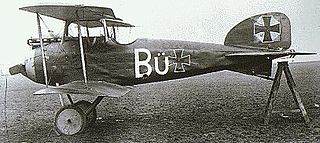
The Albatros D.I was a German fighter aircraft used during World War I. Although its operational career was short, it was the first of the Albatros D types which equipped the bulk of the German and Austrian fighter squadrons (Jagdstaffeln) for the last two years of the war.

Friedrichshafen FF.33 was a German single-engined reconnaissance three-bay wing structure biplane, using twin floats, designed by Flugzeugbau Friedrichshafen in 1914 for the Marine-Fliegerabteilung aviation forces of the Kaiserliche Marine.
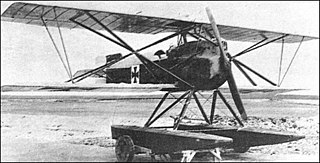
The Hansa-Brandenburg KDW was a German single-engine, single-seat, fighter floatplane of World War I. The KDW – Kampf Doppeldecker, Wasser – was adapted from the Hansa-Brandenburg D.I landplane to provide coastal defence over the North Sea.

The Friedrichshafen G.I was a prototype heavy bomber aircraft that was built in Germany by Flugzeugbau Friedrichshafen in 1915. It was Karl Gehlen's first design for the company, and although it was not produced in quantity, it provided the foundation for the later, highly successful bombers culminating in the G.III.

The Roland D.VI was a German fighter aircraft built at the end of World War I. It lost a fly-off to the Fokker D.VII, but production went ahead anyway as insurance against problems with the Fokker.
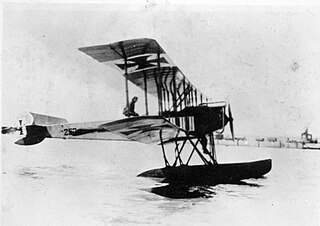
The Gotha WD.2 and its derivatives were a family of military reconnaissance aircraft produced in Germany just before and during the early part of World War I.
The Siemens-Schuckert R.III was a prototype bomber aircraft built in Germany during World War I. It was one of six aircraft based on the Siemens-Schuckert R.I that were originally intended to be identical, but which each developed in a different direction and were designated as different aircraft types by the German Inspectorate of Flying Troops. The aircraft's development was impeded by the unreliability of its Maybach HS engines, and when it was eventually accepted for military service, it was only in a training role.

The Albatros C.II was a 1910s German military pusher reconnaissance biplane designed and built by Albatros Flugzeugwerke. Only one aircraft was built and the type did not enter production.

The Luft-Fahrzeug-Gesellschaft (LFG) Roland D.VII was a German single seat, single engine biplane fighter aircraft built during World War I. Problems with its underdeveloped V-8 engine prevented its production.
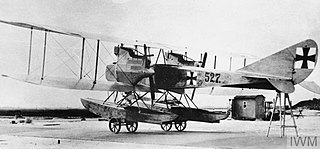
The Albatros W.3, company designation VT, was a biplane torpedo bomber floatplane prototype, built for the Imperial German Navy during the First World War. Only one was built.
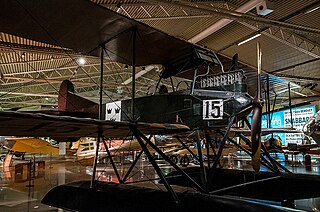
The Thulin G was a Swedish military reconnaissance aircraft built in the late 1910s.
The Aviatik C.IX was a prototype German observation aircraft built by Aviatik in the final months of World War I.
The Aviatik C.VIII was a prototype German observation aircraft built by Aviatik in World War I.
The LVG D.IV was a German fighter plane built by LVG in World War I.
The LVG D.VI was a prototype German biplane fighter built by LVG in World War I.

The Thulin NA was a prototype Swedish fighter plane built in the late 1910s.
The Thulin N was a prototype Swedish scout aircraft built in the late 1910s.

The Thulin E was a Swedish reconnaissance aircraft built in the late 1910s.
The Kawanishi K-3 was a Japanese, fast, multi-purpose civil transport aircraft from the early 1920s. Despite its good performance it was eclipsed by the release of Army surplus machines and only one was built.